Input interpretation

arsenic trichloride
Chemical names and formulas
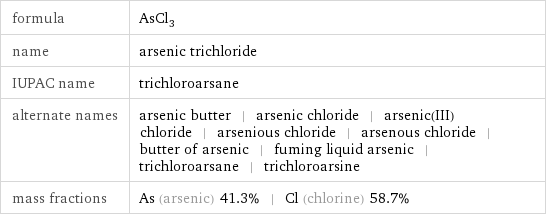
formula | AsCl_3 name | arsenic trichloride IUPAC name | trichloroarsane alternate names | arsenic butter | arsenic chloride | arsenic(III) chloride | arsenious chloride | arsenous chloride | butter of arsenic | fuming liquid arsenic | trichloroarsane | trichloroarsine mass fractions | As (arsenic) 41.3% | Cl (chlorine) 58.7%
Lewis structure
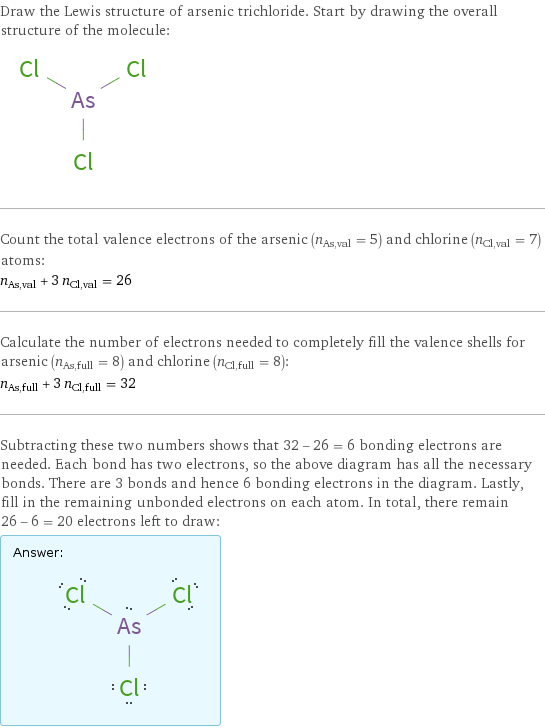
Draw the Lewis structure of arsenic trichloride. Start by drawing the overall structure of the molecule: Count the total valence electrons of the arsenic (n_As, val = 5) and chlorine (n_Cl, val = 7) atoms: n_As, val + 3 n_Cl, val = 26 Calculate the number of electrons needed to completely fill the valence shells for arsenic (n_As, full = 8) and chlorine (n_Cl, full = 8): n_As, full + 3 n_Cl, full = 32 Subtracting these two numbers shows that 32 - 26 = 6 bonding electrons are needed. Each bond has two electrons, so the above diagram has all the necessary bonds. There are 3 bonds and hence 6 bonding electrons in the diagram. Lastly, fill in the remaining unbonded electrons on each atom. In total, there remain 26 - 6 = 20 electrons left to draw: Answer: | |
Basic properties
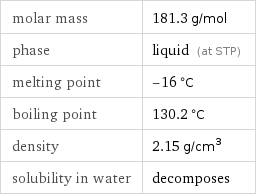
molar mass | 181.3 g/mol phase | liquid (at STP) melting point | -16 °C boiling point | 130.2 °C density | 2.15 g/cm^3 solubility in water | decomposes
Units

Liquid properties (at STP)

density | 2.15 g/cm^3 vapor pressure | 10 mmHg dynamic viscosity | 9.77×10^-6 Pa s (at 35 °C) surface tension | 0.02 N/m refractive index | 1.6006
Units

Thermodynamic properties
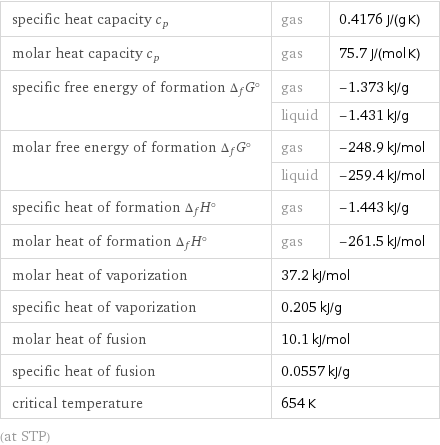
specific heat capacity c_p | gas | 0.4176 J/(g K) molar heat capacity c_p | gas | 75.7 J/(mol K) specific free energy of formation Δ_fG° | gas | -1.373 kJ/g | liquid | -1.431 kJ/g molar free energy of formation Δ_fG° | gas | -248.9 kJ/mol | liquid | -259.4 kJ/mol specific heat of formation Δ_fH° | gas | -1.443 kJ/g molar heat of formation Δ_fH° | gas | -261.5 kJ/mol molar heat of vaporization | 37.2 kJ/mol | specific heat of vaporization | 0.205 kJ/g | molar heat of fusion | 10.1 kJ/mol | specific heat of fusion | 0.0557 kJ/g | critical temperature | 654 K | (at STP)
Chemical identifiers
Cl InChI identifier | InChI=1/AsCl3/c2-1(3)4 RTECS number | CG1750000 MDL number | MFCD00014165](../image_source/a81209f9cd7d3653849b2ad793d647e8.png)
CAS number | 7784-34-1 PubChem CID number | 24570 PubChem SID number | 24851956 SMILES identifier | Cl[As](Cl)Cl InChI identifier | InChI=1/AsCl3/c2-1(3)4 RTECS number | CG1750000 MDL number | MFCD00014165
NFPA label

NFPA label
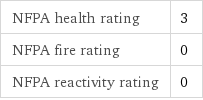
NFPA health rating | 3 NFPA fire rating | 0 NFPA reactivity rating | 0
Toxicity properties

RTECS classes | mutagen